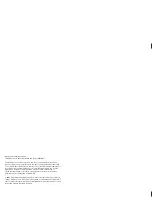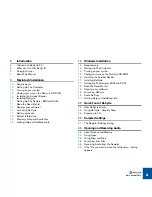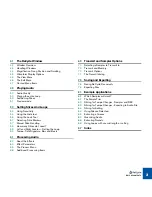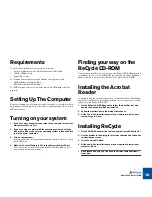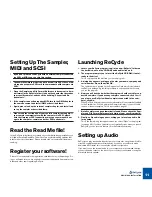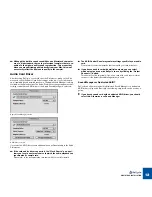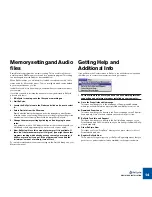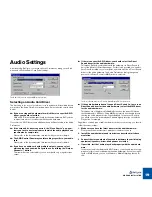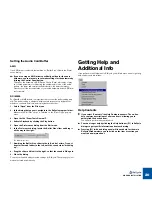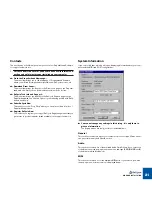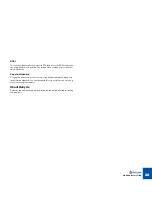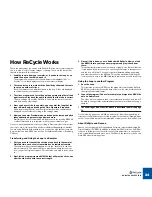
MACINTOSH INSTALLATION
11
Setting Up The Sampler,
MIDI and SCSI
!
If you don’t plan to use ReCycle with an external sampler connected
via SCSI or MIDI, you can skip this section.
!
The newer Macintosh models do not have built in SCSI. These mod-
els require a separate SCSI card to communicate with samplers via
SCSI.
1. Open the Sampler and File Format Reference (a document in Acro-
bat format in the ReCycle folder), look up the chapter that describes
your specific sampler, and check the heading “Support and Re-
quirements”.
2. If the sampler connection requires MIDI, turn to the OMS chapter in
the same document and install OMS as described there.
3. Again, please look up the relevant sampler chapter, and install and
set up the sampler as described there.
!
Please read the section about your specific sampler thoroughly! If
your sampler communicates with the computer via SCSI, please
note that improper SCSI connections may cause permanent dam-
age to the computer, sampler and other SCSI peripherals.
Read the Read Me file!
In the ReCycle folder that was created on your hard disk during installation you
will find a file called Read Me. This will contain any late-breaking updates that
didn’t make it into the manual. Please double click on it and read it before pro-
ceeding.
Register your software!
Please fill out and send in the registration card that comes in this package. Do-
ing so will make sure you are entitled to technical support and kept aware of up-
dates and other news regarding ReCycle.
Launching ReCycle
1. Locate your ReCycle program icon (in the new “ReCycle” folder on
the hard disk,
not
on the CD-ROM) and double click on it.
2. The program prompts you to insert the ReCycle CD-ROM (if not al-
ready in the drive).
This is only required the first time you run the program.
3. A dialog box appears, asking you to enter your name, company and
serial number. Do so, then click OK.
The serial number is printed on the Registration Card which is included in
the ReCycle package. Again, this procedure is only required the first time
you run the program.
4. Now, you will be asked whether the program should search for con-
nected samplers. If you have any samplers connected, click Yes; if
you plan to use ReCycle without samplers connected to the com-
puter, click No.
When ReCycle finds a properly connected sampler, it is automatically added
to the Sampler list. You can modify the Sampler list later if you wish to add,
remove or rename samplers. This is described on page 31.
!
Not all samplers can be automatically found. Please check the Sam-
pler and File Format Reference for details of your specific model(s).
5. Finally, an Open dialog appears, asking you to locate an audio file
for opening.
This is the same dialog that appears when you select “Open” in the program
(see page 36). If you don’t want this to automatically open when you launch
ReCycle, you can turn this feature off in the Preferences dialog.
Setting up Audio
ReCycle can play back audio directly from your computer, using the built-in Ma-
cintosh Sound Manager driver. Alternatively, if you have a sound card with a
dedicated ASIO driver, this is usually the optimal configuration.
If you want to use the internal audio in your computer, we recommend that you
connect the audio output on the back to your sound system instead of using the
Macintosh built in speaker.
Summary of Contents for ReCycle
Page 3: ...D D D D Table of Contents...
Page 6: ...TABLE OF CONTENTS 4...
Page 7: ...1 D D D D Introduction...
Page 10: ...INTRODUCTION 8...
Page 11: ...2 D D D D Macintosh Installation...
Page 17: ...3 D D D D Windows Installation...
Page 25: ...4 D D D D Quick Tour of ReCycle...
Page 31: ...5 D D D D Sampler Settings...
Page 36: ...SAMPLER SETTINGS 34...
Page 37: ...6 D D D D Opening and Receiving Audio...
Page 42: ...OPENING AND RECEIVING AUDIO 40...
Page 43: ...7 D D D D The ReCycle Window...
Page 51: ...8 D D D D Playing Audio...
Page 55: ...9 D D D D Setting Slices And Loops...
Page 63: ...1 0 D D D D Processing Audio...
Page 70: ...PROCESSING AUDIO 68...
Page 71: ...1 1 D D D D Transmit and Sampler Options...
Page 76: ...TRANSMIT AND SAMPLER OPTIONS 74...
Page 77: ...1 2 D D D D Saving and Exporting...
Page 82: ...SAVING AND EXPORTING 80...
Page 83: ...1 3 D D D D Example Applications...
Page 89: ...D D D D Index...


